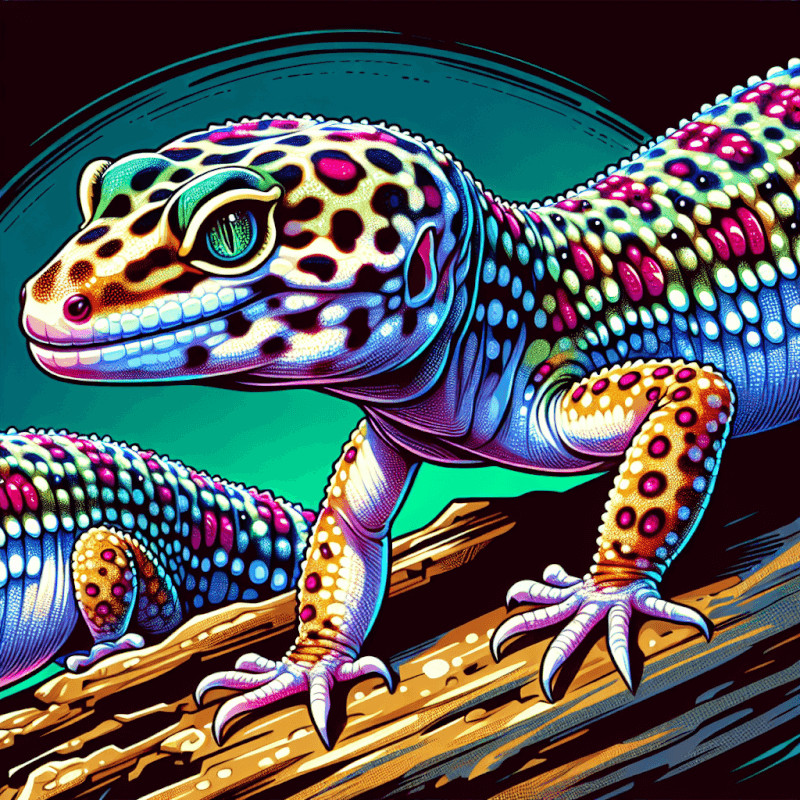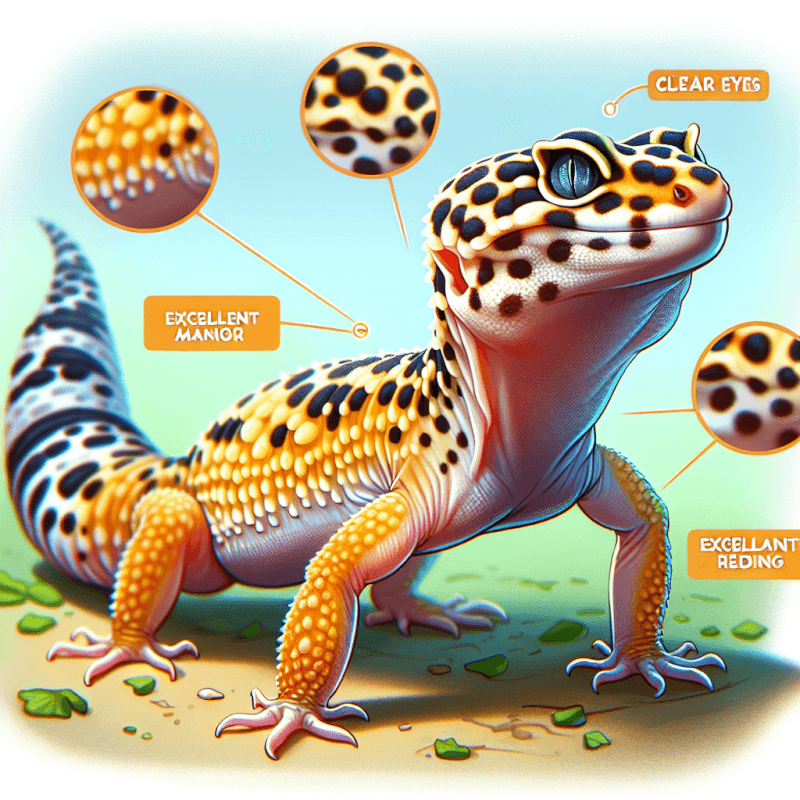If you’re the proud owner of a leopard gecko or thinking about getting one, it’s crucial to know what signs indicate a healthy gecko. A vibrant and thriving leopard gecko will showcase several key indicators, such as a plump tail, clear eyes, smooth skin, and a voracious appetite. By familiarizing yourself with these signs, you’ll be equipped to ensure the well-being of your leopard gecko and provide it with the care it needs to thrive.
Physical Appearance
Skin Texture
A healthy leopard gecko will have smooth and supple skin. The skin should not be dry or flaky, as this could indicate dehydration or a health issue. As you gently stroke your gecko’s skin, it should feel soft. If you notice any rough patches or lesions, it may be a sign of an underlying problem and should be checked by a veterinarian.
Eyes
The eyes of a healthy leopard gecko should be clear and bright, without any discharge or crustiness. They should be open and alert, with the gecko actively using its eyes to observe its surroundings. If you notice any cloudiness, swelling, or discharge, it could be a sign of an eye infection or other health issue.
Mouth
Inspecting the mouth of your leopard gecko is crucial to determine its overall health. The mouth should be clean, with no signs of redness, swelling, or sores. The gums should be pink and the teeth should be aligned properly. Additionally, a healthy gecko’s mouth will not have excessive saliva or a foul odor. Any abnormalities in the mouth could indicate an underlying health issue and should be addressed by a reptile veterinarian.
Tail
A healthy leopard gecko will have a plump and well-rounded tail. The tail serves as a fat storage reserve for these reptiles, so a thin or skinny tail may indicate a lack of nutrients or potential health problems. It’s important to remember that leopard geckos do lose their tails as a defense mechanism, but a regrown tail should resemble the original in shape and plumpness.
Limbs
Inspecting the limbs of your leopard gecko is essential to ensure their mobility and overall well-being. The limbs should be symmetrical, free from swelling or deformities, and capable of supporting the gecko’s body weight. Take note of any difficulty your gecko may have in moving around or any signs of weakness, as these could be signs of injury or disease.
Activity Level
Exploration
A healthy leopard gecko will exhibit a natural curiosity and desire for exploration. They will actively move around their enclosure, investigating their surroundings and engaging with their environment. By observing your gecko’s movement and exploratory behaviors, you can gauge its activity level and assess its overall health.
Hunting
Leopard geckos are nocturnal hunters, and a healthy gecko will display a strong hunting instinct. They should actively chase and capture their prey, demonstrating agility and precision. If you notice a lack of interest in hunting or a decline in appetite, it may be cause for concern and should be addressed.
Basking
Leopard geckos require a basking spot to regulate their body temperature, and a healthy gecko will utilize this area regularly. They should spend time basking under the heat source to absorb warmth and digest their food properly. If your gecko avoids the basking spot or spends an excessive amount of time there, it could be a sign of temperature regulation issues or underlying health problems.
Physical Alertness
A healthy leopard gecko will be physically alert and responsive to its surroundings. It should demonstrate awareness and react to stimuli, such as movement or noise. An active and alert gecko is indicative of good health, while lethargy or lack of response may be a sign of illness or stress.

Appetite
Eating Frequency
Leopard geckos have a healthy appetite and should feed regularly. They are insectivores, so their diet primarily consists of live insects. A healthy gecko will readily accept and consume its food, displaying enthusiasm and vigor during feeding time. Any significant changes in appetite, such as a sudden decrease or refusal to eat, may indicate an underlying health issue and should be investigated.
Food Preference
Leopard geckos have specific dietary requirements and preferences. They usually prefer a variety of small insects, such as crickets, mealworms, and dubia roaches. A healthy gecko will actively seek out and consume these food items. It’s important to provide a balanced and nutritious diet to ensure their well-being. Consult with a reptile veterinarian for guidance on the appropriate diet for your leopard gecko.
Weight Maintenance
Monitoring your leopard gecko’s weight is crucial for assessing its overall health. A healthy gecko will maintain a stable weight within a healthy range for its age and size. Sudden weight loss or gain may be indicative of underlying health issues, such as parasites or improper nutrition. Regular weighing and observation of your gecko’s body condition can help detect and address any weight-related concerns.
Hydration
Drinking Behavior
Leopard geckos obtain their hydration through licking water droplets or lapping water from shallow dishes. They may also absorb moisture through their skin. A healthy gecko will display a normal drinking behavior, actively seeking out water when needed. Observe whether your gecko drinks regularly and if it demonstrates typical drinking patterns.
Moist Skin
Leopard geckos generally have dry skin, but maintaining some level of moisture is crucial for their well-being. Healthy geckos will exhibit moderately moist skin, neither overly dry nor overly damp. If you notice excessively dry or flaky skin, it may be an indication of inadequate hydration or an underlying health issue.
Supplemental Water
In addition to lapping water and moisturizing through their skin, occasional misting or providing a separate moist hide can help maintain optimal hydration for your leopard gecko. Mist the enclosure lightly to simulate dewy conditions, ensuring the droplets on various surfaces are accessible to your gecko. This additional source of water can supplement their hydration, especially during shedding or in particularly arid environments.

Digestion
Regular Bowel Movements
A healthy leopard gecko will have regular and consistent bowel movements. The frequency and appearance of their feces may vary depending on their diet, but irregular or infrequent bowel movements can be cause for concern. Monitor your gecko’s fecal output to ensure it is within a normal range.
Stool Consistency
The consistency of your leopard gecko’s stool can provide valuable insights into its digestive health. Healthy geckos will have firm, well-formed feces. Loose or watery stools may indicate gastrointestinal issues or improper digestion. Pay attention to any changes in stool consistency and consult with a reptile veterinarian if concerns arise.
Absence of Undigested Food
When inspecting your gecko’s feces, ensure there are no undigested food particles present. A healthy leopard gecko will digest its food efficiently, leaving no recognizable traces in its feces. The absence of undigested food is a positive sign that your gecko’s digestive system is functioning properly.
Shedding
Smooth Skin Shedding
Leopard geckos shed their skin regularly as they grow. A healthy gecko will shed its skin in one complete piece, including the skin on its toes and eyes. The shed skin should be intact and undamaged, indicating a healthy shedding process. If you notice partial shedding or stuck shed, it may be necessary to provide proper humidity or assistance to help your gecko complete the shedding process.
Complete Shedding
During shedding, a healthy leopard gecko will shed its skin completely, leaving no remnants attached to its body. Incomplete shedding can lead to discomfort, compromised mobility, and potential health problems. Ensure that your gecko has access to a humid hide and monitor the shedding process closely to assist if necessary.
Shedding Frequency
The shedding frequency of a leopard gecko may vary depending on its age, growth rate, and environmental conditions. Generally, younger geckos shed more frequently than adults. However, each gecko is unique, and it’s important to observe your individual gecko’s shedding patterns. Consistent shedding at appropriate intervals suggests a healthy leopard gecko.

Respiratory System
Clear Nostrils
Inspecting your gecko’s nostrils is essential to ensure its respiratory system is functioning properly. The nostrils should be clear and free from any discharge or blockages. If you notice any mucus, bubbles, or difficulty breathing, it could be a sign of respiratory issues or infections. Seek veterinary attention if you have concerns about your gecko’s respiratory health.
Audible Breathing
Leopard geckos have a quiet and unobtrusive breathing pattern. Healthy geckos should not display any wheezing, gasping, or audible breathing sounds. If you notice any unusual sounds or signs of respiratory distress, it is important to seek immediate veterinary care.
Breathing Rate
A healthy leopard gecko’s breathing rate should be regular and steady. Observe your gecko’s breathing for any rapid or labored breaths, as these could indicate stress, illness, or respiratory problems. If you notice any abnormal breathing patterns, it is crucial to consult with a reptile veterinarian for a proper diagnosis and treatment.
Temperature Regulation
Proper Heat Source
Leopard geckos require a thermal gradient within their enclosure to regulate their body temperature effectively. A healthy gecko will utilize the available temperature zones, including a warm basking spot and a cooler area. It is important to provide a reliable heat source, such as an under-tank heater or a heat lamp, and ensure that the temperature gradient meets the specific requirements for leopard geckos.
Thermoregulation Behavior
A healthy gecko will demonstrate thermoregulation behavior, actively moving between warmer and cooler areas of its enclosure according to its temperature needs. Observe your gecko’s behavior to ensure it is taking advantage of the available temperature gradient. If your gecko consistently stays in one area or exhibits signs of overheating or cold exposure, it may indicate a problem with temperature regulation.
Normal Body Temperature
The ideal body temperature for a leopard gecko ranges between 88°F and 92°F (31.1°C and 33.3°C) under the basking spot, while the cooler side should be around 75°F to 80°F (23.9°C to 26.7°C). Use a reliable thermometer to monitor the temperature inside the enclosure and ensure that your gecko’s body temperature remains within a healthy range. Any significant deviations from the recommended temperature range may impact your gecko’s overall health.

Bone Health
Limbs Mobility
A healthy leopard gecko should display full mobility and functionality of its limbs. It should be able to move freely, climb, and grasp objects without any signs of discomfort or difficulty. Observe your gecko’s movements and note any hesitation, limping, or favoring of certain limbs, as these could indicate issues with bone health or injury.
Absence of Swelling
Inspect your gecko’s limbs for any signs of swelling, especially around the joints. Swelling may indicate inflammation or injury. Healthy geckos should have limbs that appear symmetrical and free from any abnormal bulges or deformities.
Strong Jaw Muscles
A leopard gecko’s jaw muscles play a crucial role in their ability to catch and consume prey. Healthy geckos will have strong and well-developed jaw muscles, enabling them to efficiently crush and consume their food. Observe your gecko during feeding to ensure it can open and close its mouth without any signs of difficulty or pain.
Social Behavior
Compatibility with Tank Mates
Leopard geckos are generally solitary reptiles and may exhibit territorial behavior when housed with other geckos. However, some leopard geckos can coexist peacefully with compatible tank mates. If you choose to keep multiple geckos together, monitor their interactions closely. Healthy geckos will display appropriate social behavior, such as sharing hiding spots, without showing signs of aggression or stress.
Activates in the Evening
Leopard geckos are primarily nocturnal and become more active during the evening and night. A healthy gecko will exhibit increased movement and engagement with its environment during these periods. If your gecko remains lethargic or inactive during its active hours, it may indicate underlying health issues that require attention.
Alertness to Surroundings
A healthy leopard gecko will be attentive and alert to its surroundings. It should show interest in its environment, visually tracking movement and responding to stimuli. If you notice a persistent lack of engagement or decreased alertness, it may indicate health problems or stress. Proper environmental enrichment and a suitable habitat can promote your gecko’s overall well-being.
In conclusion, by closely observing your leopard gecko and paying attention to their physical appearance, activity level, appetite, hydration, digestion, shedding, respiratory system, temperature regulation, bone health, and social behavior, you can determine whether they are displaying the signs of a healthy leopard gecko. Regular check-ups with a reptile veterinarian are recommended to ensure that any potential health issues are promptly identified and addressed, contributing to the overall well-being and happiness of your beloved gecko.



